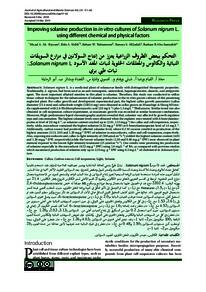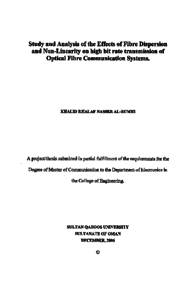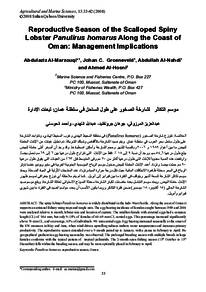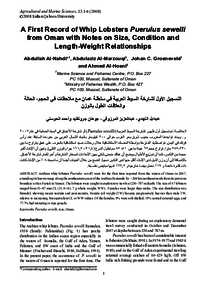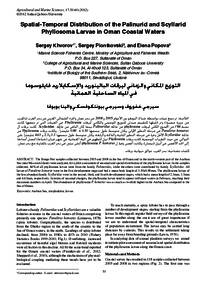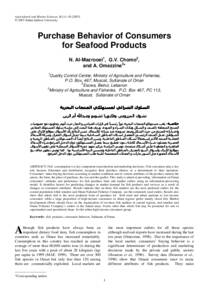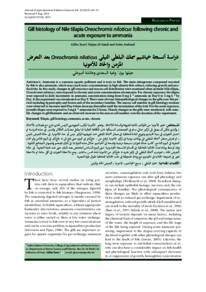Document
Improving solanine production in in vitro cultures of Solanum nigrum L. using different chemical and physical factors.
Contributors
Shibli, Rida A., Author
Tahtamouni, Reham W., Author
AlQudah, Tamara S., Author
Abu-Iramaileh, Bashaer B., Author
Publisher
Sultan Qaboos University
Gregorian
2019
Language
English
English abstract
Solanum nigrum L. is a medicinal plant of solanaceae family with distinguished therapeutic properties. Traditionally, S. nigrum. had been used as an anti-tumorgenic, antioxidant, hepatoprotective, diuretic, and antipyretic agent. The most important alkaloid member in this plant is solanine. Therefore, this study was conducted to utilize tissue culture techniques for the enhancement of solanine production in the in vitro grown cultures of this promising neglected plant. For callus growth and development experimental part, the highest callus growth parameters (callus diameter (21.4 mm) and callus fresh weight (2202.4 mg) were obtained in callus grown on Murashige & Skoog MS media supplemented with 2,4-Dichlorophenoxyacetic acid (2.0 mg•L-1) plus 1.5 mg•L-1 Thidiazuron. Similar trend was also obtained in cell suspension culture experiment, as maximum growth was recorded at similar hormone combination. Moreover, High-performance liquid chromatography analysis revealed that, solanine was affected by growth regulator type and concentration. The highest solanine levels were obtained when the explants were treated with 6-benzylaminopurine at level of 2.0 mg•L-1, as solanine content reached up to (2.61, 1.53 mg.g-1) for callus and cell suspension, respectively, while, microshoot contained the highest solanine (4.52 mg.g-1 DW) at 6-benzylaminopurine level of 1.6 mg.L-1. Additionally, carbon source had positively affected solanine level, where 0.2 M sucrose resulted in production of the highest amounts (3.13, 2.03 and 1.20 mg.g-1 DW) of solanine in microshoots, callus and cell suspension, respectively. Also, exposing microshoots and callus to light intensity of (100 μmol.m-2s-1) yielded the highest solanine content (4.03 and 1.26 mg.g-1 DW, respectively),while the lowest solanine levels (1.50 and 0.48 mg.g-1 DW) were observed in plant material exposed to the lowest light intensity treatment (25 μmol.m-2s-1). Our results were promising for production of solanine especially in the microshoot (4.52 mg.g-1 DW) using 1.6 mg.L-1 of BA, as compared with previous studies which maximized production of solanine only up to 2.33 mg. g-1 DW using 0.5 mg.L-1 of cholesterol in Solanum lyratum.
Member of
ISSN
2410-1079
Resource URL
Citation
AL- Kiyyam, M. A., Shibli, R. A., Tahtamouni, R. W., AlQudah, T. S., & Abu-Iramaileh, B. B. (2019). Improving solanine production in in vitro cultures of Solanum nigrum L. using different chemical and physical factors. Agricultural and Marian Sciences Jou
Arabic abstract
المغد الأسود .Solanum nigrum L نباتٌ طيٌّ ينتمي للعائلة الباذنجانية ويتميز بخصائصه العلاجية المميّزة، فقد استخدم تقليديا كعامل مضاد للأورام ومضاد للأكسدة ومضاد للسمية الكبدية، وكمدر للبول وخافض للحرارة. يعد السولانين القلويد الأكثر أهمية في هذا النبات. لذلك أجريت هذه الدراسة مستخدمة تقنيات الزراعة النسيجية لتعزيز إنتاج السولانين في هذا النبات الواعد والمستحق للمزيد من الاهتمام وباستعمال مزارع النمو المختبرية. لوحظ في القسم التجريبي المتعلق بنمو الكالوس وتطوره أنّ القيم الأعلى لنمو الكالوس المزروع (قطر الكالوس: 21.4 مم، ووزنه الرطب: 2202.4 مغ) قد تم الحصول عليها باستعمال وسط موراشج وسكوج MS مضافا له حمض Dichlorophenoxyacetic-2.4 (2 مغ. ل 1-) ,(1.5 مغ. ل 1-) Thidiazuron. كما تم التوصل إلى تأثر مماثل في تجربة زراعة المعلق الخلوي، حيث سُجلت أقصى قيمة للنمو باستعمال المزيج الهرموني ذاته. علاوة على ذلك، كشف التحليل اللوني السائل عالي الأداء أن السولانين قد تأثر بنوع وتركيز منظم النمو، فقد تم تسجيل أعلى مستويات للسولانين عندما عولجت العينات النباتية ب(2.0 مغ.ل1-) من benzylaminopurine -6. حيث وصل محتوى السولانين (2.61، 1.53 مغ. غ1-) في كل من الكالوس والمعلق الخلوي، على التوالي، في حين احتوت السويقات النباتية على أعلى مستوى من السولانين (4.52 مغ. غ1- ماء مقطر) عند إضافة (1.6 مغ.ل1-) من benzylaminopurine -6. كما كان لمصدر الكربون أثر إيجابي في مستوى السولانين، حيث أدى استعمال 0.2 مول من السكروز إلى إنتاج كميات أعلى من السولانين (3.13، 2.03، 1.20 مغ. غ1- ماء مقطر) في كل من السويقات النباتية والكالوس والمعلق الخلوي على التوالي. وكذلك فإن تعريض السويقات النباتية والكالوس لشدة الضوء البالغة (100 ميكرومول.متر2- ثانية 1-) قد حقق أعلى محتوى من السولانين (4.03 و1.26 مغ.غ1- ماء مقطر) على التوالي، بينما لوحظت أدنى مستويات للسولانين (1.50 و0.48 مغ.غ1- ماء مقطر) في المواد النباتية عند تعرضها لأدنى معالجة من شدة الضوء (25 ميكرومول.متر2- ثانية 1-).
Category
Journal articles

